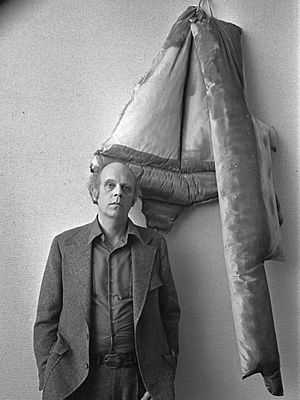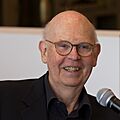Claes Oldenburg facts for kids
Quick facts for kids
Claes Oldenburg
|
|
|---|---|

Oldenburg in 1985
|
|
| Born | January 28, 1929 Stockholm, Sweden
|
| Died | July 18, 2022 (aged 93) New York City, U.S.
|
| Nationality |
|
| Education | |
| Known for | Sculpture |
|
Notable work
|
List of public art by Oldenburg and van Bruggen |
| Movement | |
| Spouse(s) | |
| Awards |
|
Claes Oldenburg (born January 28, 1929 – died July 18, 2022) was a famous artist. He was born in Sweden and later became an American citizen. He was best known for his amazing public art installations. These are often huge copies of everyday objects.
Another cool part of his work was making "soft sculptures." These were also everyday items, but made from soft materials. Many of his artworks were created with his wife, Coosje van Bruggen. She was also an artist and passed away in 2009. Oldenburg lived and worked in New York City for most of his life.
Contents
Claes Oldenburg's Early Life and School
Claes Oldenburg was born in Stockholm, Sweden, on January 28, 1929. His father was a Swedish diplomat. This meant his family moved a lot. In 1936, his father became a consul general in Chicago. So, Claes grew up there. He went to the Latin School of Chicago.
After high school, he studied literature and art history. He went to Yale University from 1946 to 1950. Then he returned to Chicago. He took art classes at The School of the Art Institute of Chicago. In 1953, he became an American citizen. In 1956, he moved to New York City. There, he learned even more about art history on his own.
Claes Oldenburg's Art and Famous Works
Oldenburg started selling his art in Chicago. He moved back to New York City in 1956. There, he met other artists. They were exploring new ways to make art. This was different from the popular "abstract expressionism" style.
In 1957, Oldenburg started thinking about "soft sculpture." His first piece was a woman's stocking filled with newspaper. It was later called Sausage. By 1960, he made sculptures of simple figures and signs. He used materials like cardboard and newspapers. In 1961, he started making sculptures from chicken wire and plaster. These looked like everyday things, like clothes and food.
In the 1960s, Oldenburg became part of the pop art movement. This art style used images from popular culture. He also created "happenings." These were live art performances. He called his own shows "Ray Gun Theater." His first wife, Patty Mucha, often performed in these shows. She also sewed many of his early soft sculptures. Oldenburg's art was often funny and bold. It was very different from the serious art of the time. But people loved his unique style.
In December 1961, he opened "The Store" in New York. It was a shop filled with sculptures. These sculptures looked like everyday items you'd buy.
Oldenburg moved to Los Angeles in 1963. He started drawing ideas for huge outdoor monuments. These were imaginary at first. For example, he drew a giant teddy bear in New York's Central Park. He also drew giant lipsticks in London's Piccadilly Circus. In 1967, his first outdoor public art happened. It was called Placid Civic Monument. It involved digging a large hole behind the Metropolitan Museum of Art.
Many of Oldenburg's large sculptures were first met with jokes. But they later became very popular. For example, Lipstick (Ascending) on Caterpillar Tracks (1969) was first at Yale University. It was bright and modern. It stood out against the serious old buildings.
From the 1970s, Oldenburg focused on public art projects. He started working with Coosje van Bruggen in 1976. They got married in 1977. From 1981, all their artworks were signed by both of them. Their first joint project was Trowel I. It was a giant garden tool sculpture.
In 1988, they created the famous Spoonbridge and Cherry. This sculpture is in the Minneapolis Sculpture Garden. It's a well-known image of the city. Another famous work is Typewriter Eraser, Scale X (1999). It's in the National Gallery of Art Sculpture Garden. They also made the Free Stamp in downtown Cleveland.
They also worked with architect Frank Gehry. They created Toppling Ladder With Spilling Paint in Los Angeles. And the huge Giant Binoculars in Venice Beach.
In 2000, the city of Milan, Italy, asked them to create Needle, Thread and Knot. In 2001, they made Dropped Cone. It's a huge upside-down ice cream cone on a building in Cologne, Germany. In 2011, Paint Torch was installed in Philadelphia. It's a giant paintbrush, 53 feet tall. It looks like it's painting at a steep angle.
Art Shows

Oldenburg had his first solo art show in 1959. It showed his drawings and papier-mâché sculptures. He had big shows at famous museums. These included the Museum of Modern Art in New York in 1969. Also, the Tate Gallery in London in 1970. In 1995, a large show of his work traveled to many places. These included the Solomon R. Guggenheim Museum in New York.
In 2002, the Whitney Museum of American Art showed his drawings. The same year, the Metropolitan Museum of Art showed some of his sculptures on its roof.
Awards and Recognition
Claes Oldenburg won many awards for his art. In 1989, he won the Wolf Prize in Arts. In 2000, he received the National Medal of Arts. This is a very important award in the United States. He also received honorary degrees from several universities.
Oldenburg and Coosje van Bruggen also received many awards together. They were recognized for their amazing teamwork in sculpture.
Claes Oldenburg's Personal Life
Patty Mucha was Claes Oldenburg's first wife. They were married from 1960 to 1970. She was an artist too. She often modeled for his paintings. She also performed in his "happenings."
Between 1969 and 1977, Oldenburg was in a relationship with artist Hannah Wilke. They shared studios and traveled together.
Oldenburg met his second wife, Coosje van Bruggen, in 1970. She was a museum curator in Amsterdam. They got married in 1977. They bought a small castle in France in 1992. They decorated it with modern furniture. Coosje van Bruggen passed away in 2009 from breast cancer.
Claes Oldenburg's brother, Richard E. Oldenburg, was also important in the art world. He was the director of the Museum of Modern Art in New York for many years.
Claes Oldenburg passed away on July 18, 2022. He was 93 years old. He died at his home in Manhattan.
Images for kids
-
Flying Pins by Claes Oldenburg and Coosje van Bruggen, Eindhoven, Netherlands
-
Giant Pool Balls (1977) by Claes Oldenburg and Coosje van Bruggen for Skulptur Projekte Münster, Münster, Germany
-
The Garden Hose, Freiburg im Breisgau, Baden-Württemberg, Germany
-
Screw Arch, Museum Boijmans Van Beuningen, Rotterdam, Netherlands
-
Shuttlecocks by Claes Oldenburg and Coosje van Bruggen, Nelson-Atkins Museum of Art, Kansas City, Missouri, USA
-
Spring 2006, Coosje van Bruggen and Claes Oldenburg, Cheonggyecheon, Seoul, South Korea
-
Bottle O' Notes, Middlesbrough, North Yorkshire, England, UK
-
Clothespin is a weathering steel sculpture by Claes Oldenburg, located at Centre Square, 1500 Market Street, Philadelphia, USA
See also
 In Spanish: Claes Oldenburg para niños
In Spanish: Claes Oldenburg para niños











